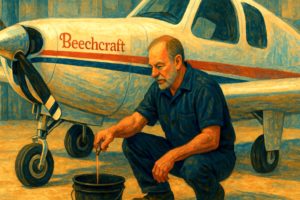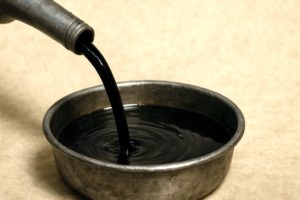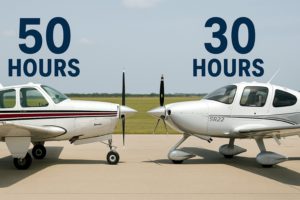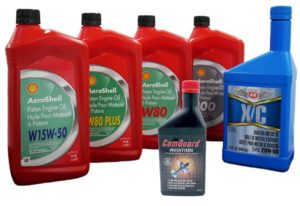
I got my first car when I was 17 years old. It was a green 1947 Plymouth sedan, a hand-me-down from my parents that they used as an excuse to buy a brand new 1961 Chrysler.I remember back then that the gasoline was heavily leaded, the engine oils were refined from dead dinosaurs, and the auto manufacturers recommended changing the oil every 2,000 miles. Nowadays, with unleaded gasoline and modern synthetic oils, the recommended interval for most vehicles is 7,500 to 15,000 miles. At typical highway speeds, 10,000 miles equates to about 200 hours of driving—much more for city driving.
In contrast, the recommended oil change interval for piston aircraft engines is a lot shorter. Continental and Lycoming recommend changing the oil every 25 to 50 hours. Rotax allows 100 hours if the engine is run on unleaded mogas and synthetic oil, but that drops to 50hours if the engine is run on 100LL more than 30% of the time, and drops to 25 hours if it’s more than 50%.
WHY SO OFTEN?
Why do we change the oil so often? It’s not because the oil breaks down in service and its lubricating qualities degrade. The fact is that conventional petroleum-based oils retain their lubricating properties for hundreds of hours, and synthetic oils retain them considerably longer.
No, the reason we change oil in our aircraft engines this often is not because it breaks down. It’s because it gets contaminated after 25 to 50 hours in an aircraft engine. In fact, it gets downright filthy and nasty.
Compared with automotive engines, our piston aircraft engines permit a far greater quantity of combustion byproducts—notably carbon, sulfur, oxides of nitrogen, raw fuel, partially burned fuel, plus lots of steam (water)—to leak past the piston rings and contaminate the oil in the crankcase. This yucky stuff is collectively referred to as “blow-by” and it’s quite corrosive and harmful when it builds up in the oil and comes it contact with expensive bottom-end engine parts like crankshafts and camshafts and lifters and gears.
To make matters much worse, 100LL avgas is heavily laced with the octane improver tetraethyl lead (TEL),which also does nasty things when it blows by the rings and gets into the crankcase. Oil change intervals for cars doubled after mogas became unleaded, and the same thing is likely to happen once leaded avgas goes away.
Aircraft engines have much more blow-by than auto engines. Their cylinders and pistons are much larger, and their air-cooled design means that tolerances are much looser. They are filthy beasts, and they require frequent oil and oil filter changes to get rid of the blow-by contaminants before they build up to levels that are harmful to the engine’s health

Figure 2. The most important reason for changing the oil is to get the filth out.
Another reason to change the oil frequently—arguably even more important than disposing of contaminants—is to replenish the oil’s additive package, particularly its acid neutralizers. When sulfur and oxides of nitrogen mix with water, they form sulfuric acid and nitric acid.You might remember these dangerous corrosives from your high school chemistry class. You definitely don’t want them attacking your expensive engine parts.
To prevent such acid attack, aviation oils are blended with acid neutralizer additives.These are alkaline substances that neutralize these acids, much as we might use baking soda to neutralize battery acid. These acid neutralizers are consumed by the process of neutralizing acids, so it’s imperative that we replenish them before they get used up to an extent that might jeopardize our hardware. Of course, the way we replenish them is to change the oil.
HOW OFTEN?
How often do we need to change the oil? Well, I’m a big fan of doing preventive maintenance on-condition instead of on a fixed timetable. In theory, we could do our oil changes on-condition by regularly sending oil samples to a lab and doing oil changes only when the oil analysis showed the oil was getting tired. Specifically, we’d change the oil either when the quantity of particulate matter in the oil became excessive or when the acid neutralizers were used up.
Some oil labs—notably Blackstone Labs (www.blackstone-labs.com)—routinely report on the quantity of “insolubles.” This is a measure of how much particulate matter is found in the oil sample. If insolubles exceed 2%, then the oil is dirty and needs to be changed.
Two other tests—Total Base Number (TBN) and Total Acid Number (TAN)—relate to oil acidity. TBN reports the amount of acid neutralizers in the oil, and TAN reports the acidity of the oil sample. If TBN is low or TAN is high, it’s time to change the oil. TheTBN test is most valuable. Fresh virgin aircraft engine oil typically has a TBN around 10. By the time the TBN decreases to 2 or 3, the acid neutralizers are nearly used up and it would be wise to change the oil ASAP. Routine oil analysis reports usually won’t includeTBN or TAN, but most oil labs can include them if you ask.
Of course, most owners(including me)don’t bother with such oil condition monitoring and simply change their oil at a conservative interval that’s guaranteed to get the junk out and fresh additives in before anything untoward is likely to occur.I generally do oil change sat 50 hours or 4 calendar months, whichever comes first.This works well for my Continental TSIO-520-BB engines with their big 12-quart sumps. But not all engines can go this long between oil changes.
Consider the Continental IO-550-N and TSIO-550-K engines used in theCirrus SR22, or the Continental TSIO-550-C in the Columbia 400 andCessna Corvallis/TTx. These engines have a big displacement (550 cu. in.) and an unusually small oil sump capacity (8quarts). Most operators keep their oil level between 5 and 6 quarts, since filling the sump to the 8-quart mark on the dipstick usually results in the top two quarts getting tossed out the engine breather in short order.

Figure 3. Engines with large displacement and small oil capacity need more frequent oil changes.
As you might imagine, asking just 5 or 6 quarts of oil to hold the blow-by from those six big cylinders in suspension is a tall order, resulting in considerably more rapid oil contamination than, say, an IO-550-B in a Bonanza whose oil capacity is a generous 12quarts, typically run at 9-10 quarts.The Bonanza is a good candidate for 50-hour oil changes, but the Cirrus SR22 and Cessna Corvallis would do better with an oil-change interval of 30 to 35 hours. For your own engine, divide the displacement (in cu. in.) by the typical operating oil quantity (in quarts).Do this calculation and you’ll find that the Bonanza engine scores 55while the Cirrus/Corvallis engines score 91.67and a Lycoming IO-360 run at 6 quarts scores 60. As a rule of thumb, if your engine scores over 70, you’d be wise to change the oil more often. All this assumes that your engine uses a full-flow oil filter. Some older engines aren’t equipped with a filter, just a pressure screen. This results in more rapid particulate contamination of the oil. So, if you’re flying behind one of those, you really need to change the oil every 25 hours or less to keep insolubles from getting out of control. Or, better yet, retrofit your engine with an STC’d oil filter adapter. This also assumes that you’re running on 100LL.If you’re using unleaded mogas or avgas, you should be able to go longer between oil changes.Once unleaded avgas becomes widely available and 100LL is phased out, it strikes me as likely that we’ll be able to lengthen our oil-change intervals considerably—conceivably even double them.That’s certainly what happened when auto gasoline got the lead out.
CHOOSING OIL AND ADDITIVES
Much has been written, stated, posted and debated about the pros and cons of various types and brands of aircraft engine oil.We used to have more choices than we do now.Mobil AV 1 synthetic oil was withdrawn from the market in the mid-1990s in a hail of lawsuits involving engines that were ruined by accumulation of lead sludge. More recently, Exxon discontinued its Elite 20W-50 semi-synthetic multivis oil in 2019 for undisclosed reasons. That leaves only two oil brands in the U.S. piston aircraft oil space:Phillips 66 and Shell.
There are still plenty of choices. Both Phillips and Shell offer a variety of mineral-based (i.e.,all petroleum) ashless dispersant (AD) oils, both mono-and multi-viscosity, both with and without anti-wear additives. Shell also offers a semi-synthetic multivis anti-wear oil(Aeroshell 15W-50). Both also offer non-AD non-anti-wear oils that some prefer for new cylinder break-in.
Our piston aircraft engines—by virtue of their low RPMs, low operating temperatures, and loose dimensional clearances—have extremely modest lubrication requirements(compared to high-revving automotive engines) which can easily be satisfied by virtually any brand and type of aviation oil. Awhile back, Blackstone Labs performed an analysis that compared the wear metals generated by 571 Lycoming IO-360 engines using four types of oil: AeroshellW100, Aeroshell 15W-50, Exxon Elite 20W-50, and PhillipsX/C20W-50. They found no significant difference in wear metals between the four types of oil.
But lubrication is not the only thing we need from our aircraft engine oil.We rely on oil to keep our engines clean inside by capturing all that filthy blow-by and wear metal particles and holding it in suspension so that it can be drained out at the next oil change rather than forming sludge that clogs oil passages and piston rings.This is primarily the job of ashless dispersants in AD oil, engineered molecules with polar heads that stick to contaminants and long hydrocarbon tails that keep them suspended in the oil. As with acid neutralizers, these ashless dispersants get used up as the oil becomes contaminated with particulates, so regular oil changes are needed to ensure the engine’s internal cleanliness.
Lead contaminants due to leaded fuel are a special case.Synthetic oils such as polyalphaolefin (PAO) cannot hold them in suspension very well, creating vulnerability to build-up of nasty lead sludge. Mobil found this out the hard way with the Mobil AV 1debacle. Shell still offers its semi-synthetic Aeroshell 15W-50that uses a 50-50 mixture of mineral oil and PAO as sort of a compromise between the better lubricity and longevity of PAO and the better lead dispersant ability of petroleum. Since semi-synthetics have significantly less lead-dispersing capability than all-mineral oils, you might want to avoid them if you’re flying behind an engine with a high displacement-to-oil-capacity ratio such as the Cirrus/Corvallis engines discussed earlier. Once we’re able to run these engines on unleaded fuel, semi-synthetics and even full-synthetics may well become the oils of choice.
There are times when moving metal parts in our engines rub against one another without the benefit of an adequate oil film to keep them hydrodynamically separated. Notably, this happens at every engine start, especially “dry starts” after the engine has been idle for awhile. Metal-to-metal contact can also occur between compression rings and cylinder walls near top dead center when the piston slows to a stop and reverses direction. This is where anti-wear (also known as anti-scuff) additives come in.These are typically phosphates—such as tricresyl phosphate (TCP) and triphenyl phosphate(TPP)—that chemically inhibit micro-welds between the contacting surfaces that are responsible for friction and wear. These friction modifier additives are important for all engines, but especially ones (like mine) that fly irregularly and sit unflown a lot.
We also rely on oil to protect the expensive steel parts of our engines from rusting during periods of disuse, especially if the aircraft lives in an area of moderate or high environmental corrosion risk (e.g., near the coast), and especially if it lives outdoors. If cold-weather starts are not an issue, I prefer mono-viscosity oil like AeroshellW100 or Phillips Type A because they’re thick and gooey at room temperature and strip off parts more slowly. Some oils and aftermarket additives contain anti-rust additives that provide additional corrosion protection.

SOME RECOMMENDATIONS
For my own Cessna 310 based on the central coast of California, I use Aeroshell W100 mono-viscosity AD oil to which I add ASL CamGuard, a very effective combination of anti-rust and anti-wear additives. My airplane flies irregularly, sits unflown a lot, and lives in a hangar just a few miles from the Pacific Ocean. The combination of mono-vis AD oil and CamGuard has provided me with sensational engine longevity. For my clients who deal with cold-weather starts where multi-viscosity oil is needed, my first choice recommendation is Phillips X/C 20W-50 multi-vis AD oil with CamGuard added for anti-corrosion and anti-wear protection.
CamGuard is relatively expensive, and some folks prefer not to use it. For them, I recommend oils like Aeroshell W100 Plus or Phillips Victory 20W-50 that are pre-blended with anti-wear additives. Aeroshell 15W-50 is also a possibility, although as previously discussedI’d avoid it for engines running on leaded avgas that have a high displacement-to-oil-capacity ratio.
Both Phillips and Shell offer non-AD oils for cylinder break-in. However, I’ve never seen any credible evidence that AD oils aren’t just as good for break-in as so-called straight mineral oils like Aeroshell 100 (without the “W”) and Phillips Type M. I can personally vouch forAeroshell W100 and Phillips X/C 20W-50as excellent break-in oils. However, it’s important to avoid oils with anti-wear additives until break-in is complete, so don’t use Aeroshell Plus or Phillips Victory or Aeroshell 15W-50, and don’t add friction modifiers like CamGuard or Lycoming LW-16702until break-in is complete.
Finally, both Phillips and Shell offer special preservative oils for use in “pickling” and engine during extended periods of disuse. Phillips Anti-Rust Oil and Aeroshell Fluid 2Fare excellent choices for pickling. Another good choice is mono-viscosity engine oil with a double dose (10% concentration) of CamGuard.
Now please excuse me, I need to drive to my hangar and change my oil